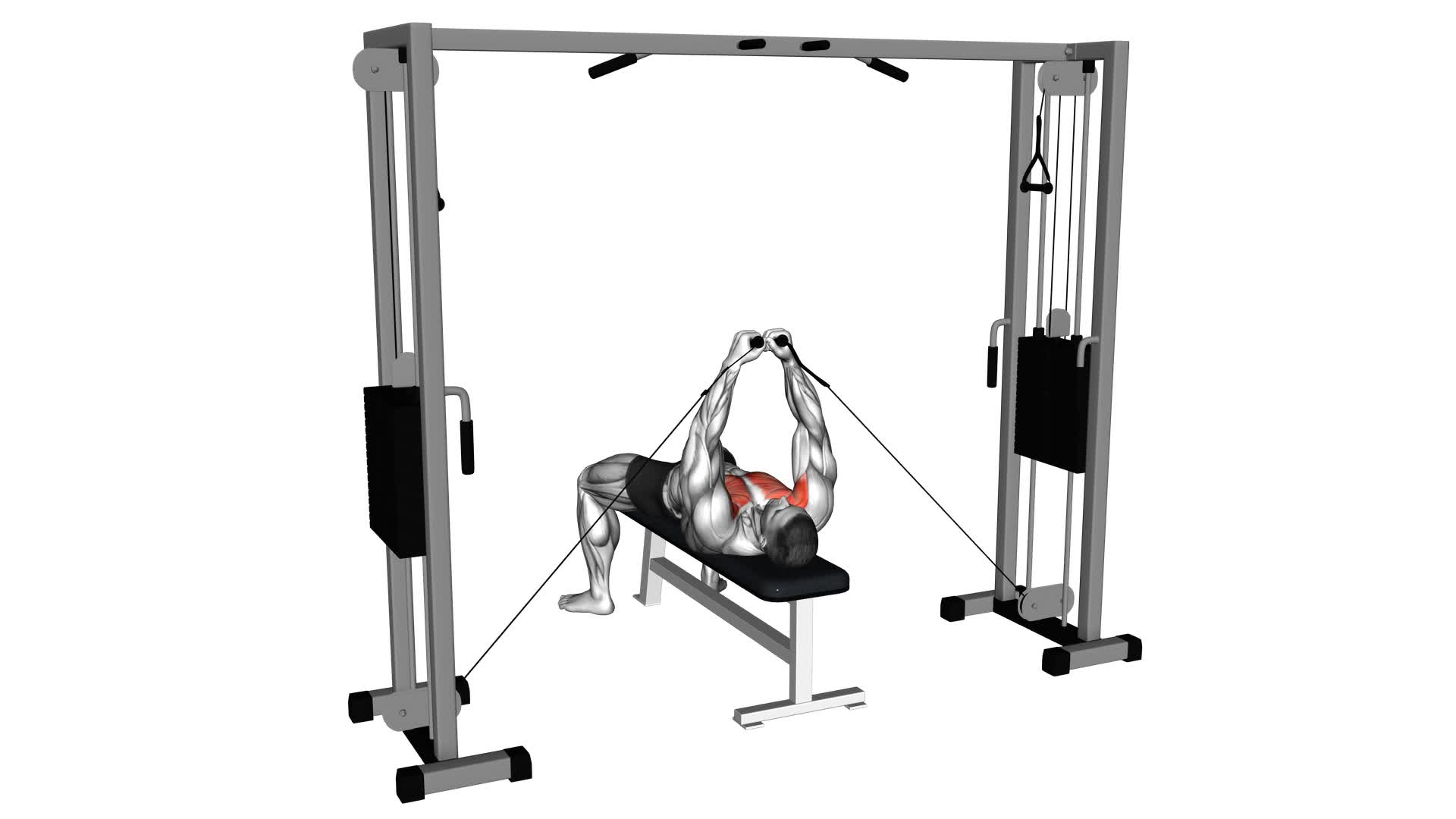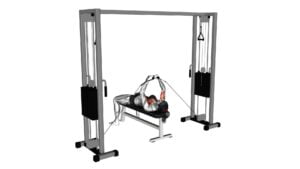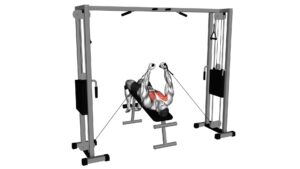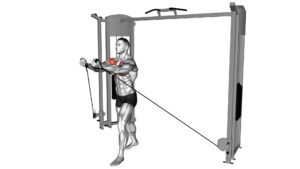Cable Lying Fly – Video Exercise Guide & Tips

Are you looking to strengthen your chest muscles? Look no further than the cable lying fly!
Watch This Exercise Video
This video exercise guide will show you the proper form and technique for performing this effective exercise.
With variations and tips for maximizing results, you'll be on your way to a stronger, more defined chest in no time.
Don't let common mistakes hold you back – watch the video and get started on your cable lying fly journey today!
Key Takeaways
- Cable lying fly targets chest muscles effectively and works pectoralis major and minor.
- It allows for a wide range of motion and engages chest muscles throughout the entire movement.
- Cable lying fly also engages shoulders and triceps as secondary muscles.
- Proper form and technique, such as maintaining a slight bend in elbows and avoiding common mistakes, is crucial for maximum muscle activation.
Benefits of Cable Lying Fly
One of the main benefits of the Cable Lying Fly is that it targets the chest muscles effectively. This exercise specifically works the pectoralis major and minor, helping to build strength and definition in the chest area. The Cable Lying Fly allows for a wide range of motion, which helps to engage the chest muscles throughout the entire movement.
To maximize your Cable Lying Fly results, it's important to incorporate different variations of the exercise. This can include adjusting the height of the cables, using different grip positions, or incorporating different angles of movement. By varying these factors, you can target different areas of the chest and stimulate muscle growth from different angles.
In addition to targeting the chest muscles, the Cable Lying Fly also engages the shoulders and triceps as secondary muscles. This makes it a compound exercise that can help improve overall upper body strength and stability.
When performing the Cable Lying Fly, it's essential to maintain proper form and technique. This includes keeping your back flat against the bench, maintaining a slight bend in your elbows, and using controlled movements throughout the exercise. By focusing on proper form, you can prevent injuries and ensure that you're effectively targeting the intended muscles.
Equipment Needed for Cable Lying Fly
So, you're ready to give the Cable Lying Fly exercise a try? Great choice! To get started, you'll need some essential equipment.
First and foremost, you'll need access to a cable machine or a resistance band with handles. These tools will provide the necessary resistance to target your chest muscles effectively.
If you don't have access to a cable machine or resistance band, don't worry! There are alternative exercises you can try to still engage your chest muscles.
Essential Equipment for Cable Lying Fly
To perform the Cable Lying Fly exercise, you'll need an adjustable cable machine. This machine allows you to adjust the height and tension of the cables, which is crucial for targeting specific muscles during the exercise.
While there are alternatives to the cable lying fly, such as dumbbell flyes or resistance bands, the cable machine provides a unique advantage. It allows for constant tension throughout the movement, ensuring maximum muscle activation and growth.
To achieve better results with the cable lying fly, focus on maintaining proper form and control throughout the exercise. Keep your core engaged, chest lifted, and shoulders relaxed. Gradually increase the weight and intensity as your strength improves.
Remember to always consult with a fitness professional before attempting any new exercise.
Alternatives to Cable Lying Fly
If you don't have access to an adjustable cable machine, there are alternative equipment options for performing the Cable Lying Fly exercise. One option is the dumbbell fly, which can be done lying on a flat bench or an incline bench. Simply lie down and hold a dumbbell in each hand, with your arms extended out to the sides. Slowly lower the dumbbells down towards the floor, feeling a stretch in your chest.
Another alternative is the resistance band fly. Attach a resistance band to a fixed object and hold one end in each hand. Step back to create tension in the band, then bring your hands together in front of your chest, squeezing your pecs.
With these exercises, you can still work your chest muscles without the need for a cable machine.
Now, let's move on to the proper form and technique for the cable lying fly.
Proper Form and Technique for Cable Lying Fly
Now let's talk about the key points to keep in mind when it comes to the proper form and technique for the cable lying fly exercise.
First and foremost, the positioning of your arms is crucial. Be sure to maintain a slight bend in your elbows throughout the movement to engage your chest muscles effectively.
Additionally, it's important to be aware of common mistakes to avoid, such as using too much weight or allowing your shoulders to hunch forward.
Arm Positioning Importance
You should focus on your arm positioning for proper form and technique during the Cable Lying Fly exercise. Proper arm positioning is crucial for maximizing muscle activation and getting the most out of this exercise. Here are three key points to remember:
- Keep your arms slightly bent: Avoid locking your elbows and maintain a slight bend throughout the movement. This helps to maintain tension in the target muscles and reduces the risk of injury.
- Maintain a controlled range of motion: Avoid swinging your arms or using momentum to lift the weights. Instead, focus on a slow and controlled movement, squeezing your chest muscles at the top of the contraction.
- Keep your shoulders down and back: Pull your shoulder blades together and down towards your spine. This helps to stabilize your shoulders and prevents them from rolling forward.
Common Mistakes to Avoid
To ensure proper form and technique for the Cable Lying Fly exercise, it's important to be aware of common mistakes that should be avoided.
One common mistake is forgetting to focus on proper breathing. Remember to inhale as you lower the cables and exhale as you bring them back up. Proper breathing helps stabilize your core and enhance muscle activation.
Another mistake isn't engaging the targeted muscles fully. Make sure to squeeze your chest muscles at the top of the movement and maintain tension throughout.
Lastly, avoid using excessive weight that compromises your form. It's better to use lighter weights with proper form than heavy weights with improper form.
Benefits of Proper Technique
By utilizing proper form and technique for the Cable Lying Fly exercise, you can experience a range of benefits. Here are three reasons why correct posture and maximizing gains are essential:
- Targeted Muscle Activation: Performing the Cable Lying Fly with proper form ensures that you're effectively targeting your chest muscles. This exercise engages the pectoralis major and minor, helping to strengthen and tone your chest.
- Injury Prevention: Maintaining correct posture throughout the exercise helps to prevent unnecessary strain on your shoulders and back. By keeping your spine aligned and shoulders stabilized, you reduce the risk of injury and promote overall safety during the workout.
- Improved Muscle Growth: Using proper technique allows you to fully engage and activate your chest muscles, maximizing gains and promoting muscle growth. By focusing on the correct movement and form, you create the optimal environment for muscle hypertrophy.
Variations of Cable Lying Fly
The cable lying fly exercise has several variations that can be incorporated into your workout routine. These variations allow you to target different areas of your chest and engage your muscles in different ways.
One variation is the incline cable lying fly, which targets the upper chest muscles. To perform this variation, adjust the bench to an incline position and follow the same proper form and technique as the regular cable lying fly.
Another variation is the decline cable lying fly, which targets the lower chest muscles. Adjust the bench to a decline position and perform the exercise in the same manner.
Additionally, you can try the single-arm cable lying fly, which allows you to focus on each side of your chest individually. Hold one handle with one hand and perform the exercise, then switch to the other side.
Remember to maintain proper form and technique for each variation, keeping your back flat on the bench, elbows slightly bent, and squeezing your chest muscles as you bring the cables together.
Incorporating these variations into your workout routine can help you achieve a well-rounded chest workout and maximize your results.
Tips for Maximizing Results With Cable Lying Fly
To maximize your results with the cable lying fly, focus on proper form and technique while engaging your chest muscles. Here are three tips to help you maximize the intensity and activate your chest muscles effectively:
- Slow and controlled movements: Instead of rushing through the exercise, perform the cable lying fly with slow and controlled movements. This helps to increase the time under tension, maximizing the intensity on your chest muscles.
- Squeeze at the top: When bringing the cables together, make sure to squeeze your chest muscles at the top of the movement. This contraction creates more muscle activation and enhances the effectiveness of the exercise.
- Mind-muscle connection: Focus on establishing a strong mind-muscle connection with your chest muscles throughout the exercise. Visualize your chest muscles working and contracting with each repetition. This mental focus will help you engage and activate the targeted muscles to their full potential.
By implementing these tips, you can maximize the intensity and muscle activation of the cable lying fly, resulting in greater gains and improved chest development.
Remember to always listen to your body, start with lighter weights, and gradually increase the load as you become more comfortable with the exercise.
Common Mistakes to Avoid During Cable Lying Fly
When performing the cable lying fly, it's important to avoid common mistakes that can hinder your progress and effectiveness in targeting your chest muscles. One common mistake to avoid is improper breathing. Many people hold their breath or exhale at the wrong time during this exercise. To ensure proper breathing, inhale as you lower the cables towards your chest, and exhale as you bring them back up. This will help you maintain control and stability throughout the movement.
Another mistake to avoid is lack of muscle engagement. It's essential to focus on contracting your chest muscles throughout the exercise. Don't just go through the motions without actively engaging the targeted muscles. To maximize the effectiveness of the cable lying fly, squeeze your chest muscles at the top of the movement and hold for a brief moment before slowly lowering the cables back down. This will ensure that you're getting the most out of each repetition and effectively targeting your chest muscles.
Frequently Asked Questions
How Many Sets and Reps Should I Do for Cable Lying Fly?
To maximize your workout intensity and ensure proper form, it's important to know how many sets and reps to do for cable lying fly. By targeting your chest muscles, this exercise can help you build strength and definition.
While the ideal number of sets and reps can vary depending on your fitness level and goals, a good starting point is 3 sets of 8-12 reps. Remember to always listen to your body and adjust as needed for optimal results.
Can Cable Lying Fly Help in Building Chest Muscles?
Cable lying fly is a great exercise for building chest muscles. By incorporating cable exercises into your chest workouts, you can experience a range of benefits.
This exercise specifically targets your chest muscles and helps to activate them effectively. To maximize chest muscle activation, it's important to maintain proper form and technique.
Is Cable Lying Fly Suitable for Beginners?
Yes, cable lying fly is suitable for beginners.
Incorporating cable exercises into a beginner's workout routine has many benefits. It helps in building chest muscles and improves overall upper body strength.
If you have limited upper body strength, you can modify cable lying fly by using lighter weights and focusing on proper form.
This exercise is a great way to target and strengthen your chest muscles, making it a valuable addition to your workout routine.
Are There Any Alternative Exercises That Target the Same Muscle Groups as Cable Lying Fly?
Looking for alternative exercises that target the same muscle groups as the cable lying fly? Well, you're in luck! There are a few exercises you can try.
But before we get into that, let's talk about the benefits of the cable lying fly. This exercise is great for working your chest muscles and improving upper body strength.
Now, onto the alternatives. You might want to give the dumbbell fly or the pec deck machine a try. Both of these exercises can help you achieve similar results.
Is It Necessary to Use a Spotter While Performing Cable Lying Fly?
It's important to know if using a spotter is necessary when doing cable lying fly. Proper form is crucial in this exercise to avoid injury and maximize results. Having a spotter can provide support and ensure your technique is correct.
Incorporating cable lying fly into your chest workout routine offers numerous benefits. It targets your chest muscles, strengthens your upper body, and improves overall stability.
Conclusion
In conclusion, the cable lying fly is a highly effective exercise for targeting the chest muscles. By using the proper form and technique, you can maximize your results and avoid common mistakes.
With the right equipment and variations, you can add variety to your workouts and continue challenging your muscles.
So, incorporate cable lying fly into your fitness routine and enjoy the benefits of a stronger and more defined chest.

Author
Years ago, the spark of my life’s passion ignited in my mind the moment I stepped into the local gym for the first time. The inaugural bead of perspiration, the initial endeavor, the very first surge of endorphins, and a sense of pride that washed over me post-workout marked the beginning of my deep-seated interest in strength sports, fitness, and sports nutrition. This very curiosity blossomed rapidly into a profound fascination, propelling me to earn a Master’s degree in Physical Education from the Academy of Physical Education in Krakow, followed by a Sports Manager diploma from the Jagiellonian University. My journey of growth led me to gain more specialized qualifications, such as being a certified personal trainer with a focus on sports dietetics, a lifeguard, and an instructor for wellness and corrective gymnastics. Theoretical knowledge paired seamlessly with practical experience, reinforcing my belief that the transformation of individuals under my guidance was also a reflection of my personal growth. This belief holds true even today. Each day, I strive to push the boundaries and explore new realms. These realms gently elevate me to greater heights. The unique combination of passion for my field and the continuous quest for growth fuels my drive to break new ground.







